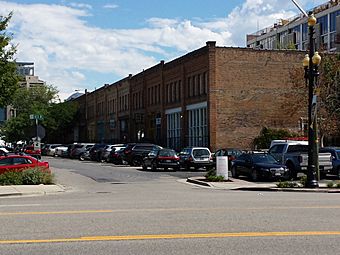Warehouse District (Salt Lake City, Utah) facts for kids
|
Warehouse District
|
|
 |
|
| Location | 200 South and Pierpont Ave. between 300 and 400 West, and roughly bounded by I-15, US 50 S., W. Temple St., 300 West & 1000 South, Salt Lake City, Utah |
|---|---|
| Area | 13 acres (5.3 ha) (original) 544 acres (220 ha) (increased) |
| Architect | Richard Kletting; Walter Ware; others |
| Architectural style | Early Commercial |
| MPS | Salt Lake City Business District MRA |
| NRHP reference No. | 82004149 (original) 16000125 (increase) |
Quick facts for kids Significant dates |
|
| Added to NRHP | August 17, 1982 March 22, 2016 (increase) |
| Boundary increase | March 22, 2016 |
The Warehouse District in Salt Lake City, Utah, is a special historic area on the city's west side. It's a place where old buildings tell stories of the past. Over the years, artists have moved into the area, and developers have helped it grow.
A small part of this district was first added to the National Register of Historic Places in 1982. This is like a special list of important historical sites in the United States. Later, in 2016, the district was made much larger to include even more historic buildings.
What is a Historic District?
A historic district is a group of buildings, structures, or sites that are important because of their history or architecture. These areas are often protected to help keep their unique character. The buildings in a historic district usually share a common past or style.
Being on the National Register of Historic Places means a place is recognized for its importance to American history. This can help protect the buildings and sometimes provides special funding for their care.
The Original Warehouse District
The first part of the Warehouse District was listed on the National Register in 1982. It included 16 buildings, mostly built between 1890 and 1927. These buildings were mainly warehouses and commercial sites.
The original district was about one city block in size. It was located around 200 South, between 300 West and 400 West in Salt Lake City. Most of these buildings were considered "contributing resources." This means they helped show the history and importance of the district. For example, the Symns Wholesale Grocery Co. building from 1892-93 was part of this group.
One building, the Trucker's Cafe, was not considered historic enough. It was later taken down. The listing of this district was part of a bigger study of historic places in Salt Lake City.
The Expanded Warehouse District Today
In 2016, the Warehouse District became much bigger. It's now almost a square mile in size! The district has an interesting, uneven shape. It is generally bordered by I-15, 50 South, West Temple Street, 300 West, and 1000 South.
The expanded district now includes 26 properties that were already on the National Register by themselves. In total, it has 197 "contributing resources." These are buildings or sites that add to the district's historical value. Many are old warehouses and business places. However, the district also includes homes.
To be a "contributing resource," a building needed to be built between 1869 and 1966. It also had to have kept most of its original look.
Experts studied the area in 2012 and 2015. They found four main periods when the district grew:
- Railroads and Outside Influences (1869-1899): This was when railroads first came to the area.
- Commercialization and Immigration (1900-1928): More businesses and people moved in during this time.
- Great Depression and World War II (1929-1945): Even during tough times, some buildings were still added.
- Post-War Era (1946-1966): Growth continued after World War II.
You can see many different building styles in the district. These include Victorian, Classical Revival, Bungalow, and Moderne. Famous architects like Walter Ware and Richard Kletting designed some of these buildings.
Even the Old Pioneer Fort Site, also known as Pioneer Park, is part of this historic district. It adds to the rich history of the area.



